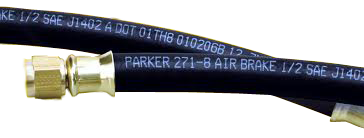D.O.T.-Approved Air Brake Hoses: Requirements, Testing Criteria, and Top Options

Ensuring the safety and legality of your vehicle's air brake system requires using hoses that comply with the Department of Transportation (D.O.T.) standards. It's a common misconception that hydraulic hoses, due to their higher pressure ratings, are suitable substitutes for air brake applications. However, D.O.T.-approved air brake hoses undergo rigorous testing beyond pressure ratings to meet specific safety criteria.
Identifying D.O.T.-Approved Air Brake Hoses
To ensure compliance, look for hoses and fittings marked with "DOT" along the layline. This designation indicates that the hose assembly has passed the necessary tests prescribed by the National Highway Traffic Safety Administration (NHTSA). Using non-approved hoses can compromise safety and may be illegal for vehicles operating on public roads.
Testing Criteria for D.O.T. Approval
The D.O.T. imposes stringent requirements on air brake hoses to ensure their safety, durability, and reliability in the demanding conditions of commercial and passenger vehicle applications. Each hose undergoes rigorous testing across multiple criteria:
Construction and Material Integrity
The hose must meet precise manufacturing standards, ensuring the materials used are durable and resistant to wear and tear. This includes the inner tube, reinforcement layers, and outer cover.
Temperature Resistance
Air brake hoses are subjected to both high and low temperature tests to confirm that they can operate effectively in extreme weather conditions without cracking, swelling, or becoming brittle.
Oil and Ozone Resistance
Since air brake hoses are often exposed to lubricants and harsh environmental conditions, they are tested to ensure resistance to oil contamination and ozone degradation, which can compromise performance.
Dimensional Stability (Length Change)
The hoses are checked for changes in length under pressure to ensure they remain stable and do not stretch or shrink excessively during operation.
Adhesion Strength
Tests are conducted to confirm the bond strength between the inner tube, reinforcement layers, and outer cover. This prevents delamination, which can lead to hose failure.
Internal Clearance and Flow
The internal diameter of the hose is measured to guarantee that it maintains proper airflow and does not restrict the performance of the braking system.
Flex Strength and Pressure Cycling
Hoses are subjected to repeated bending and pressure cycling tests to assess their flexibility and ability to withstand the continuous stresses of braking without cracking or losing integrity.
Burst Strength
Burst pressure tests ensure the hose can handle pressures well above its maximum operating range without rupturing, adding an extra margin of safety.
Corrosion Resistance
Hoses and fittings are tested for corrosion resistance, ensuring longevity even in environments where exposure to moisture and road salts is common.
Tensile Strength
The tensile strength test evaluates the hose’s ability to withstand pulling forces without failure, ensuring that the connections and fittings stay secure under load.
Water Absorption
To ensure performance in humid or wet environments, hoses are tested for their ability to resist water absorption, which could otherwise degrade materials or performance over time.
Zinc Chloride Resistance
Since some environments expose hoses to chemicals like zinc chloride, tests are conducted to verify that the materials do not weaken or degrade under such conditions.
End Fitting Integrity
Hoses are tested with their end fittings to ensure the entire assembly performs as expected under pressure and environmental stress, reducing the risk of failure at connection points.
By meeting these comprehensive standards, D.O.T.-approved air brake hoses ensure the highest level of safety and reliability, critical for preventing brake failure and maintaining compliance with legal requirements. Always verify that your air brake system uses hoses and assemblies bearing the D.O.T. marking for peace of mind on the road.
Recommended Parker D.O.T.-Approved Air Brake Hoses
Consider the following Parker air brake hoses that meet D.O.T. standards:
- Parker 201: Fiber braid cover, synthetic rubber inner tube
- Parker 206: Blue fiber braid cover, PKR inner tube
- Parker 213: Fiber braid cover, PKR inner tube
- Parker 266: Fiber braid cover, PKR inner tube
- Parker 271: Synthetic rubber construction
- Parker 293: Abrasion-resistant nylon braid cover, PKR inner tube
Selecting the appropriate D.O.T.-approved air brake hose is crucial for maintaining the safety and compliance of your vehicle's braking system.
For more detailed information on D.O.T. testing procedures and regulations, visit the Federal Motor Carrier Safety Administration's website.
Posted by Steve Winterowd




